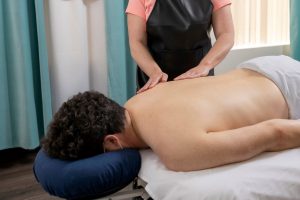A registered massage therapist adds her own measures to the required COVID-19 protocols in place at her practice.

Photo credit: © WorkSafeBC (Workers’ Compensation
Board of B.C.), used with permission
Recently I spoke with a registered massage therapist (RMT) who works with high-risk clients. She carefully follows the COVID-19 guidelines set by the College of Massage Therapists of British Columbia (CMTBC) and keeps her safety plan updated.
“I set strict guidelines for my patients because I work with vulnerable people,” says the RMT, “Jane,” who asked to remain anonymous.
Clients at greatest risk from COVID-19 exposure need to determine if they feel safe with the measures, before receiving treatment. Jane discusses possible alternatives for care with those high-risk patients. One option might include postponing treatment.
RMTs are responsible for explaining both the risks and the potential benefits of treatment, consistent with CMTBC’s Consent Standard of Practice. If the RMT and the patient agree that the benefits of the treatment outweigh the risks, the therapist can provide massage therapy.
Safe practices
All clients who choose to proceed with treatment, need to be aware of safety procedures before (or at) the first appointment. RMTs are required to get informed consent from clients, and explain that because of the nature of massage therapy, physical distancing is not possible in the treatment room.
Jane schedules 15 minutes between appointments for cleaning her treatment area. Patients are asked to wait outside until they are called to enter. Everyone wears masks in the building, in accordance with the health order, and they also wear them during the massage therapy treatment. When patients enter the clinic, and before they leave, they must wash their hands with soap and water for at least 20 seconds and dry them thoroughly. Jane only accepts electronic payments.
In addition to patients’ comfort, it’s also important that Jane feels comfortable going ahead with an appointment.
Following public health guidelines outside appointment times
Jane likes to know that her patients are following public health guidelines in their daily lives, outside of their appointments. It’s beyond the CMTBC guidelines, but these are a few of the questions she asks on the morning of patients’ appointments:
- Have you travelled outside the Lower Mainland in the last two weeks?
- Have you gone without a mask in any public indoor spaces in the last two weeks?
- Have you socialized indoors with people you do not share living space with in the last two weeks?
She tells them: “If you answer yes to any questions, it is likely I will have to cancel your appointment.” However, she doesn’t charge them in this situation. Says Jane: “I wish to encourage honesty, as an ‘untruthful’ answer will risk my health and the health of everyone I see that day.”
“For me, I’ve developed a routine. It’s easy for me to do the things I have control over,” Jane says. “I get up in the morning and check my email right away to see if my patients have filled out the COVID-19 self-assessment form. If not, I email them again. After that, I’ll text if I haven’t heard from them.”
She also turns to the Registered Massages Therapists’ Association of B.C. for COVID-19 resources that include practice guidelines, PPE suppliers, posters, notices, and more, so that she can keep her safety plan up to date.
Thanks to Jane for speaking with me about what she does to try to keep her patients and herself safe.


